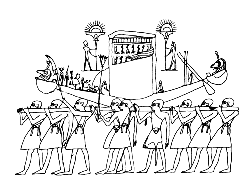
El oráculo es una declaración hecha por un dios, en ocasiones de forma espontánea, pero generalmente tras haberle sido formulada una pregunta. Aunque la costumbre es indudablemente más antigua, el primer documento fiable sobre los oráculos data del Imperio Nuevo, y sólo después de la Dinastía XX, hay una información más sustancial. En la Dinastía XXI, no sólo se consultaba el oráculo frecuentemente, sino que también se celebraba una 'festividad del oráculo' en el patio de Karnak, en concreto entre los pilares noveno y décimo. Los egipcios buscaban respuestas del oráculo a todas sus preguntas, que generalmente hacían referencia al futuro. Algunos reyes, como Hatshepsut, Thutmosis III y Herihor dejaron constancia en los templos de que fueron elegidos por el dios como los próximos gobernantes, legitimando de esta manera su reinado. La divinidad era consultada antes de las batallas en tiempo de guerra o para sofocar una rebelión extranjera. Tanto los reyes, como los sacerdotes sirvientes del dios podían ser elegidos a través de un oráculo. De igual manera, los altos funcionarios buscaban en él la aprobación de sus actos. Se presentaban ante el oráculo toda clase de situaciones y problemas de la vida cotidiana, cuestiones relacionadas con el matrimonio, la enfermedad, posesiones, aprobación de testamentos o revelación del nombre de un ladrón. En ocasiones, el oráculo era consultado cuando las partes no estaban de acuerdo o cuando no eran capaces de solucionar su caso antes de llegar al tribunal. Un texto hierático nos describe un caso de robo presentado al oráculo porque el ladrón era un miembro que formaba parte de los tribunales. En ocasiones, las preguntas se presentaban varias veces y a diferentes oráculos. Conocemos otro texto que documenta el caso de un ladrón que fue hallado culpable por el primer oráculo, pero que quería todavía probar su inocencia en otro. Una pregunta también podía ser presentada a varios dioses. A lo largo de la historia de Egipto, Amón fue el dios más popular y, en consecuencia, el más consultado. Pero en Deir el-Medina, por ejemplo, el oráculo favorito fue el divinizado rey Amenofis I, señor de este lugar. El medio de consulta más común era formular preguntas en el momento en que el dios era llevado en su barca al exterior del templo durante las procesiones. La respuesta era interpretada según los movimientos de la divinidad (si la inclinación de la cabeza era hacia delante o hacia atrás). Si no se movía significaba rechazo. Con el fin de diferenciar el rechazo de la 'no respuesta', al dios se le preguntaba primero si deseaba responder. El método de presentación de las preguntas exigía que éstas se formularan de manera que pudieran responderse mediante un 'si' o un 'no'. Las preguntas se hacían en ocasiones verbalmente, pero también se podían realizar por escrito a lo largo del recorrido, con el fin de evitar que los sacerdotes que llevaban la estatua oyeran la pregunta e influyeran en la respuesta. En algunos casos, la naturaleza del oráculo implicaba una respuesta más detallada. Los textos también sugieren que el dios hablaba realmente aunque la interpretación de los mismos está todavía en discusión. Desde la Época Romana, conocemos un tipo de oráculo que se manifestaba mediante la voz de un sacerdote escondido que resonaba a través de un tubo. Se supone que el oráculo del Oasis de Siua que proclamó a Alejandro Magno como Hijo del Dios fue realizado por un sacerdote que se ocultaba en otra habitación, desde donde escuchaba las preguntas. Un dios podía revelar sus deseos en un sueño, y así Thutmosis IV soñó que debía liberar a la esfinge de Guiza de la arena que tenía acumulada. A partir de la Baja Época, aparece la costumbre de dormir en el interior de ciertos templos, y de esta manera el dios podía dar una respuesta en forma de sueño. Se han encontrado muchos textos relativos a la interpretación de sueños, generalmente en griego y en demótico. Durante el Tercer Periodo Intermedio, aparece un tipo de amuleto que servía para proteger a la persona que lo poseía contra todo mal. Contenía un decreto escrito que declaraba que había sido emitido por el dios en forma de oráculo.